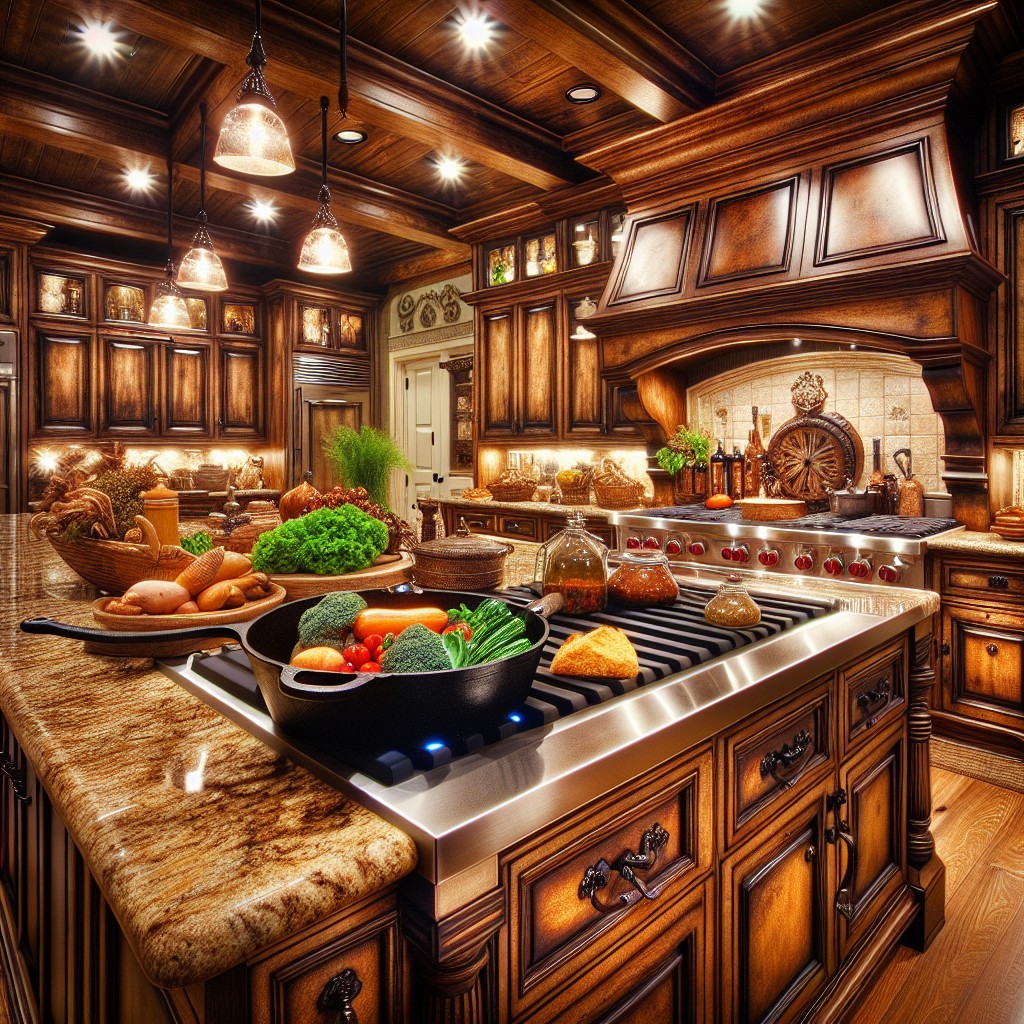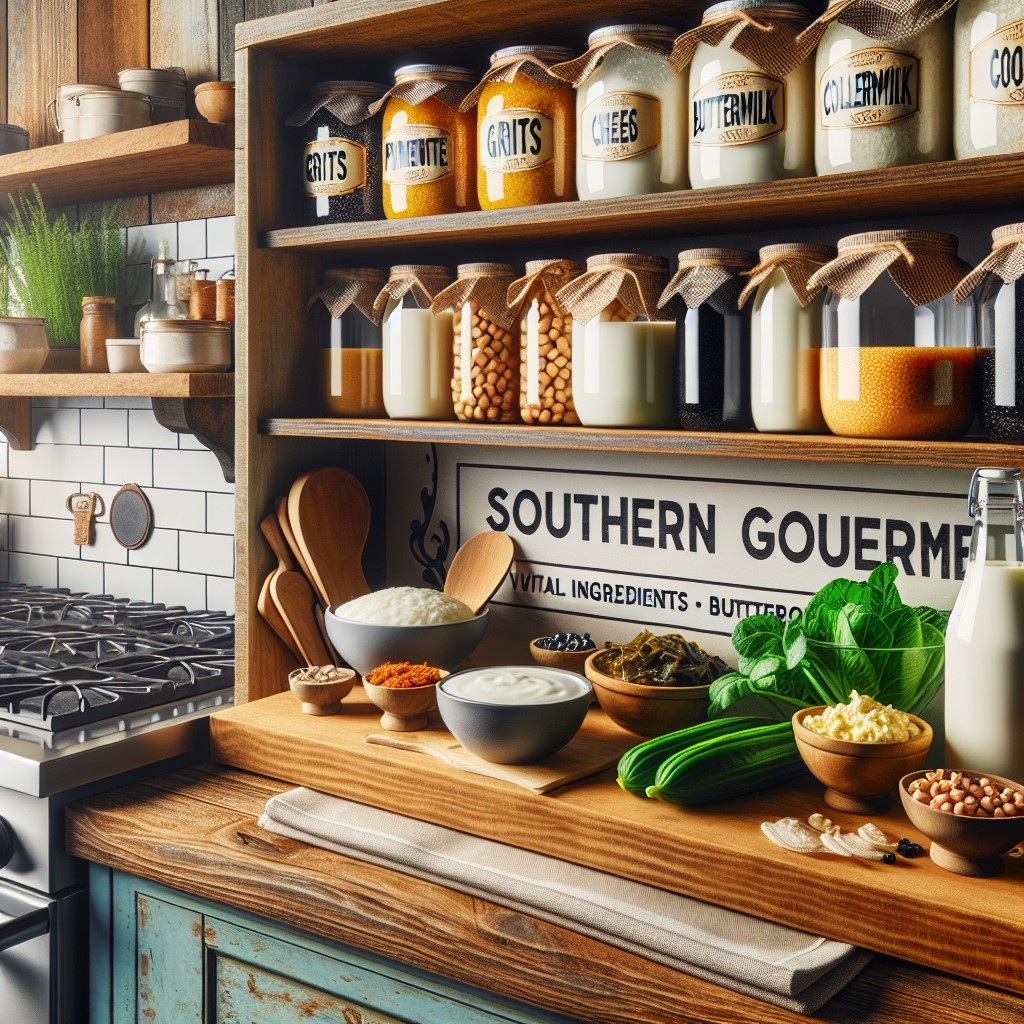Last updated on
Dive into this detailed review because the Southern Gourmet Kitchen isn’t just a restaurant, but a delightful culinary journey serving southern-style cuisine that deserves your attention.
Key takeaways:
- Southern gourmet cuisine elevates traditional Southern cooking with upscale ingredients.
- Essential ingredients include corn, tomatoes, bacon, buttermilk, peaches, and pecans.
- Typical dishes include shrimp and grits, fried green tomatoes, and pimento cheese.
- Local produce like heirloom tomatoes and collard greens play a role in shaping the cuisine.
- Seasonings and spices add complexity and balance to Southern gourmet dishes.
What's Inside
Definition of Southern Gourmet Cuisine

Rooted in a rich culinary heritage, Southern gourmet cuisine elevates traditional Southern cooking to refined levels. This style takes classic comfort foods and infuses them with upscale ingredients, artistic presentations, and complex flavor profiles, while still honoring the warmth and hospitality inherent to Southern dining.
Think of cornbread with a twist of fresh jalapeños and honey butter, or slow-cooked pork shoulder reimagined with a bourbon peach glaze. Chefs mix farm-fresh produce with precise techniques to create dishes that are both familiar and innovative, often resulting in a dining experience that resonates with both nostalgia and a sense of culinary exploration.
Southern gourmet doesn’t shy away from bold, hearty flavors; it embraces them, marries them with luxurious touches, and serves them up with a side of contemporary flair.
Essential Ingredients in Southern Gourmet Cooking

Corn, a staple grain, provides the foundation for grits, cornbread, and hominy, embodying the heartiness of the region. Heirloom tomatoes, bursting with juiciness, frequently grace salads and sandwiches, offering a sweet, tangy flavor. For a rich, smoky undertone, no Southern pantry is complete without bacon or ham hocks, enhancing everything from collards to stews.
Buttermilk plays a dual role: tenderizing proteins and adding tang to biscuits and pancakes. Peaches and berries, the jewels of Southern orchards, contribute natural sweetness to desserts and preserves. Meanwhile, pecans, revered for their buttery taste, crown pies and are often toasted for a satisfying crunch in salads.
Rounding out the essentials, local honey and molasses are not just sweeteners but ingredients that carry the whispers of the floral landscapes from which they hail, infusing dishes with a subtle depth that sugar alone cannot provide. These components, cherished by home cooks and chefs alike, are the threads that weave the rich tapestry of Southern gourmet cooking.
Typical Dishes Found in a Southern Gourmet Kitchen
Shrimp and grits take center stage as a beloved classic, highlighting local seafood and stone-ground cornmeal. This dish perfectly exemplifies the marriage of simplicity and flavor depth.
Fried green tomatoes, a testament to innovation, transforms unripe tomatoes into a crispy, savory delicacy, often complemented by a spicy remoulade.
Barbecue varieties vary by region, but all share a focus on tender, slow-cooked meats infused with smoky notes and slathered in sauces ranging from sweet and sticky to vinegary and spicy.
Chicken and waffles, a harmonious contrast of textures, sweet and savory notes, perfectly captures the soul of Southern comfort food.
Pimento cheese, known as the “caviar of the South,” serves as a versatile and creamy spread ideal for crackers, vegetables, or as a melt-in-your-mouth sandwich filling.
Biscuits and gravy showcase the prowess of Southern biscuit-making, with fluffy, buttery layers paired with creamy, meaty gravy for a filling breakfast staple.
She-crab soup, a Lowcountry specialty, combines fresh crabmeat, crab roe, and a rich sherry-infused broth, embodying coastal refinement.
Red beans and rice, a Monday tradition in Louisiana, feature creamy beans seasoned with rich spices and smoky meats, served over rice as a hearty and flavorful one-pot meal.
Influence of Local Produce On Southern Gourmet Menus
The availability of fresh, locally-sourced ingredients plays a pivotal role in shaping the profiles of southern gourmet dishes. With a climate conducive to a lengthy growing season, the South enjoys a rich variety of produce that chefs incorporate into their culinary creations.
Heirloom Tomatoes: Juicy and flavorful, these tomatoes often form the backbone of fresh salads and are a staple in many southern dishes.
Collard Greens: A quintessential southern ingredient, collards are simmered with spices and often paired with smoked meats for a rich, hearty side or entrée.
Sweet Corn: Harvested at its peak, sweet corn adds a burst of natural sweetness to soups, cornbreads, and relishes.
Peaches: Celebrated in desserts and savories alike, the succulent peach is synonymous with Southern summer flavors.
Seafood: Coastal areas offer a bounty of fresh seafood, from shrimp to catfish, which feature prominently in gumbo and jambalaya.
Pecans: From pies to pralines, pecans lend a nutty luxury to treats and are also used in savory applications like crusts for fish or chicken.
Seasonal availability impacts menu offerings, with chefs crafting dishes around what is currently at peak freshness, directly influencing the flavors and authenticity of southern gourmet cuisine.
Role of Seasonings and Spices in Southern Gourmet Recipes
The magic in Southern gourmet dishes often lies in the judicious use of seasonings and spices. They are used not just to add flavor but to build layers of complexity that resonate with every bite. Let’s delve into some key points:
- Balancing Heat and Sweetness: Cayenne and red pepper flakes bring warmth, which is skillfully balanced with a hint of sugar or honey.
- Herb Essentials: Thyme, basil, and sage are staples, delivering a fresh, earthy undertone to meats and vegetables alike.
- Smoked Paprika and Cumin: These add depth and a smoky profile to dishes, enhancing the main ingredients without overpowering them.
- Garlic’s Role: Beyond adding zest, garlic often acts as a flavor foundation, paired with onions to create a base for many sauces and gravies.
Remember, the key is to use these seasonings thoughtfully, allowing each to contribute its unique notes while maintaining harmony in the dish.
Techniques That Define Southern Gourmet Cooking
Perfecting the art of low and slow cooking is a cornerstone—in braises or barbecue, patience rewards with tenderness and depth of flavor.
Searing meats locks in juices for succulent results, often followed by simmering in a rich stock to layer in more complexity.
Frying is an art form unto itself; a golden crispy exterior yielding to perfectly cooked insides, achieved through temperature control and timing.
Smoking meats with a blend of hickory, oak, or fruitwoods imparts a distinctive taste that’s quintessentially southern.
Preservation techniques, such as pickling and canning, allow for the bounty of the seasons to be savored year-round.
Last but not least, baking pulls together many southern staples, from flaky biscuits to moist cornbread, where precision in measurements and a gentle touch ensure the ideal texture.
Signature Southern Gourmet Desserts
Indulge your sweet tooth with delectable treats that are as rich in history as they are in flavor. Southern gourmet desserts often feature locally sourced ingredients, such as pecans, peaches, and sweet potatoes. Classic dishes like pecan pie boast a sticky filling and a flaky crust, embodying the comfort of Southern baking. Similarly, peach cobbler utilizes juicy, ripe peaches topped with a buttery biscuit crust for an irresistible warmth.
Sweet potato pie provides a creamy texture with a blend of cinnamon, nutmeg, and vanilla, encapsulating the essence of Southern hospitality. Beignet, the New Orleans deep-fried pastry dusted with powdered sugar, offers a crispy yet pillowy delight that pairs beautifully with a chicory-laced café au lait.
Red velvet cake is another gem, with its distinctive look and velvety smooth cocoa flavor, typically frosted with a tangy cream cheese icing. These desserts do more than just end a meal on a high note—they tell a story of the region’s cultural tapestry through each decadent bite.
Pairing Beverages With Southern Gourmet Meals
Careful beverage selection elevates the Southern gourmet dining experience. Rich, hearty flavors of the cuisine are perfectly complemented by sweet iced tea, often referred to as the “house wine of the South.” This classic drink provides a refreshing counterbalance to spiciness and deep-fried dishes.
For a more celebratory meal, a crisp sparkling wine cuts through the richness of dishes like shrimp and grits or chicken and waffles. Bourbon is another regional favorite that can be sipped neat or mixed into a cocktail to enhance the flavors of smoky barbecue or a hearty stew.
When it comes to craft beers, choose ales with malt-forward profiles that harmonize with the savory notes of Southern meatloaf or pork chops. And for an authentic finish, consider a pecan pie or peach cobbler paired with a dessert wine or a smooth, aged bourbon that compliments the sweetness and spiciness of the desserts.
By thoughtfully pairing beverages, each bite and sip is an indulgence in Southern hospitality and culinary tradition.
Incorporating Modern Twists Into Traditional Southern Gourmet Dishes
Experimenting with fusion concepts breathes new life into time-honored Southern recipes. Chefs might introduce unexpected global flavors by infusing a classic jambalaya with Thai spices or adding a Korean BBQ twist to pulled pork, seamlessly melding the smoky sweetness with a tangy gochujang sauce.
Revamping traditional dishes with plant-based alternatives also appeals to health-conscious diners. Imagine substituting the meat in a gumbo with jackfruit, or using cashew cream in place of heavy dairy to create a rich, vegan-friendly biscuit topping for a pot pie.
Another avenue involves the deconstruction of beloved classics. For example, reimagining shrimp and grits as an elegant appetizer by serving spiced shrimp atop a crispy grit cake with a drizzle of red-eye gravy reduction demonstrates how presentation can transform a familiar dish into a gourmet experience.
Lastly, by swapping out common carbohydrates such as rice and potatoes with ancient grains like quinoa or farro, not only does the nutritional profile get a boost, but these grains also add a unique texture and taste, creating a delightful new experience for the palate.
Southern Gourmet Cooking Classes and Workshops
Attending cooking classes and workshops offers an immersive experience into the harmonious world of Southern cuisine. From mastering the art of perfect biscuit making to understanding the delicate balance of spices in a gumbo, these gatherings are a treasure trove of culinary skills. Local chefs often take the lead, sharing their expertise and secret techniques with enthusiasts.
During these interactive sessions, participants get hands-on practice with essential kitchen tools and equipment. They’re introduced to the importance of cooking timings and temperatures, which are crucial when dealing with Southern staples like fried chicken or slow-roasted meats. The workshops also provide a great opportunity to ask questions in real-time, ensuring a deeper comprehension of the process.
Sourdough starters and heirloom recipes come to life as attendees learn about heritage cooking and the significance of passing down culinary traditions. Moreover, the communal aspect of these experiences cannot be understated; working alongside fellow food aficionados fosters a sense of community and shared passion for Southern flavors.
Sustainability is also a common theme, as many classes focus on farm-to-table practices, emphasizing the use of fresh, locally-sourced ingredients. The workshop environment is conducive to discussing the best ways to select and utilize seasonal produce, meats, and seafood indigenous to the South.
By the end of a session, participants typically leave with a collection of recipes, an appreciation for the intricacies of Southern gourmet cooking, and a boost of confidence to recreate the magic in their own kitchens.
FAQ
What is the difference between a chef’s kitchen and a gourmet kitchen?
A gourmet kitchen, designed for quality meal preparation and impressing guests, stands out with its casual nature and absence of professional-level equipment that is essential in the more high-end, professional chefs kitchen.
What is included in a gourmet kitchen?
A gourmet kitchen includes impressive appliances such as warming drawers, frying stations, built-in coffee makers, and indoor smokers, often mirroring the appliances found in a professional kitchen.
What is a gourmet kitchen island?
A gourmet kitchen island is a standalone structure within a kitchen that comes equipped with additional counter space, its own sink, cabinets and drawers for storage, along with features like extra ovens, microwaves, and a supplementary dishwasher.
How does a southern gourmet kitchen incorporate regional culinary traditions?
A southern gourmet kitchen incorporates regional culinary traditions by integrating locally-produced ingredients, using traditional cooking methods like smoking and frying, and serving classic dishes such as shrimp and grits, fried green tomatoes, and pecan pie.
What are the key gadgets to have in a gourmet kitchen for southern cuisine?
Key gadgets for a gourmet kitchen specializing in southern cuisine include a slow cooker for tender meats, a cast-iron skillet for searing and frying, a quality knife set for chopping, and a biscuit cutter for perfect pastries.
Why are preparation spaces and storage solutions vital in a gourmet kitchen?
Preparation spaces and storage solutions are vital in a gourmet kitchen because they provide essential organization, workflow smoothness and ensure that all necessary tools and ingredients are easily accessible for efficient cooking.




